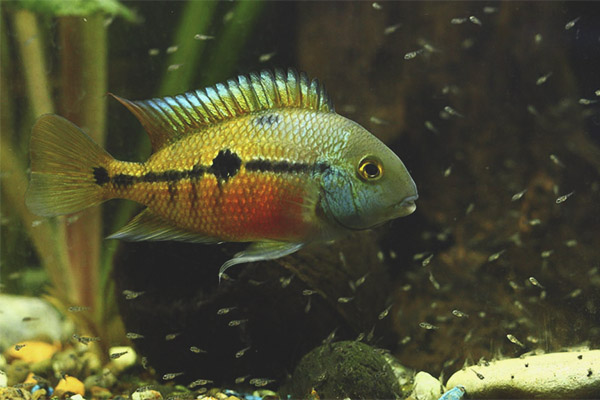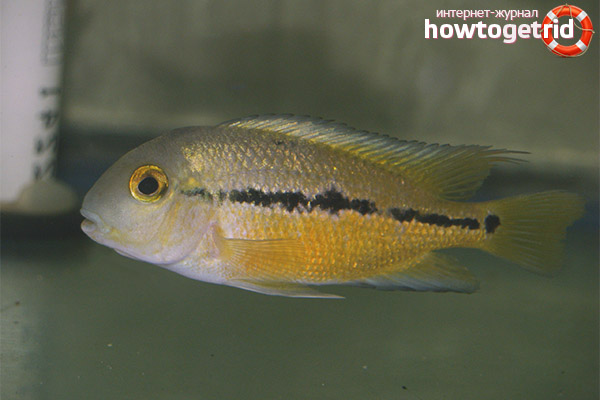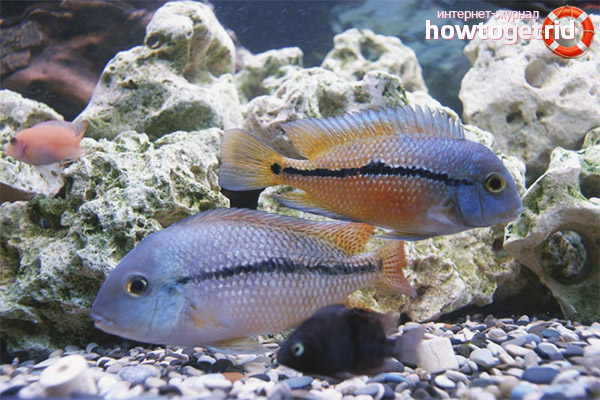The content of the article
Another type of cychlosis, which is called Nicaraguan. Fish is distinguished by unusual appearance and color, it is usually kept in species aquariums for greater effect. Females are saturated, beautiful, males are duller. However, this fact does not prevent professional aquarists and novices in this field from keeping Nicaraguan couple of chickens. They successfully multiply, do not require scrupulous care and special frills in the content. Not to be unfounded, let's look at the important aspects in order.
Origin
In 1864, Günther described this type of cichlids as unusual and interesting in behavior. Fish prefer to live near the Atlantic slope, located in Central America.
Representatives of this family can be found in lakes, slow-flowing rivers and drainage.In crossing, the Nicaraguan cichlasome is combined with the black strip. Until the fourth generation, the offspring will be fertile.
Adults by their nature feed on mollusks, small invertebrates, seeds and foliage. Fry prefer to eat aquatic insects.
Description
Chunky fish, neatly folded. The head is curved, the frontal area is moderately pronounced. The mouth is clearly visible, lips are dense and developed, the fish loves to dig the ground. A representative of the Central American cichlids in the natural environment grows up to 25 cm. At the same time, life expectancy is on average 13 years.
The body is neatly folded, massive, the color of copper with a golden sheen. The head is a shade of bluish-green. In the central part of the body there is a speck of dark tone. A line passes through the body. Plavnichki possess dark spots, and on the tail fringing reddish pigment.
There are not only basic coloring, fish can be of different shades. It all depends on the habitat, feeding conditions, as well as age and gender. Females are bright, males are dimmer.In nature, individuals are also endowed with more color than their aquarium counterparts.
If you are interested in how difficult it is to keep these fish, then the answer is easy. Large peaceful tsikhlazomy get along with representatives of this family and catfish. The main thing is to provide the fish with a spacious dwelling, to keep the aquarium clean, to properly feed the pets and to treat the neighborhood carefully.
Feeding
These cichlids are omnivores. In their habitat, they eat mainly food of plant origin. We are talking about foliage, algae, vegetation, detritus, mollusks and various types of invertebrate creatures.
To be kept in an aquarium, you need to choose food for cichlids, as well as feed your pets with frozen, live, dry food.
As an addition, they are fed with moths, clams, worms, tubers, and shrimps. From vegetables they are treated with cucumbers, zucchini, lettuce, spirulina.
Meat products are limited because they cause esophageal disorders. If you want to pamper fish with such food, do it no more than once every 2 weeks.
Content
- If you are going to contain a pair of considered tsihlazom, the aquarium should be at least 300 liters. Keep in mind that the larger the capacity, the better for everyone. Especially if you are going to acquire other types of fish.
- Such tsikhlazomy very fond of clean water and undercurrent. To achieve this you have to fork out for a water pump and a powerful cleaning filter. The problem is that after feeding from fish there is a large amount of waste.
- The bottom of the aquarium is recommended to siphon on a mandatory basis once a week. With the same frequency should be replaced a quarter of the water. Keep in mind, the situation in the aquarium should be as close as possible to the wild conditions.
- The soil should be made of sand. In addition, stones and driftwood should be placed in the aquarium. Build all kinds of shelter for fish. Considered tsikhlazomy very fond of digging in the sand. That is why you should not plant all sorts of algae.
- Alternatively, plants can be grown in separate containers. Separately, it is worth mentioning that the fish will constantly eat up the young leaves of algae.Cichlids will show particular activity during spawning.
Compatibility
- This type of cichlids practically does not differ from relatives. Nicaraguan Cichlasome is the same territorial. Therefore, it will attack everyone who comes close to its place or nest. In this case, it shows a special aggression.
- Such individuals are recommended to contain only with other cichlids. They get along well with salvini, meeka, bee and black-band. Nicaraguan cichlasomes used to hold a pair. Therefore, it is recommended to take an even number of pairs, that they have independently decided who will be with whom.
How to distinguish the female from the male
- To distinguish the female from the male representatives of this species will have to work hard. The task is not easy. The male has a larger size and a pointed fin on the back. He also has a fat bump on his forehead.
- But do not forget about the fact that the bump swells only during the mating season. The female can be distinguished by its bright color and smaller size.
Breeding
- Such tsikhlazomy can spawn in an aquarium without problems.Females spawn in pre-dug holes. So fishes need a lot of shelters and caves. Caviar in such individuals is not sticky, so they do not throw it on a flat surface.
- The female begins to spawn at a water temperature of 26 degrees. After only 3 days, the fry begin to be born. After another 5 days, the young begin to swim. From now on, the fry can be fed.
Nicaraguan tsikhlazomy belong to rather aggressive fishes. Therefore, it is better to keep them with other cichlids. Take care of the right conditions. Create a favorable atmosphere in the aquarium.
Video: Nicaraguan Cichlasoma (Cichlasoma nicaraguense)













To send